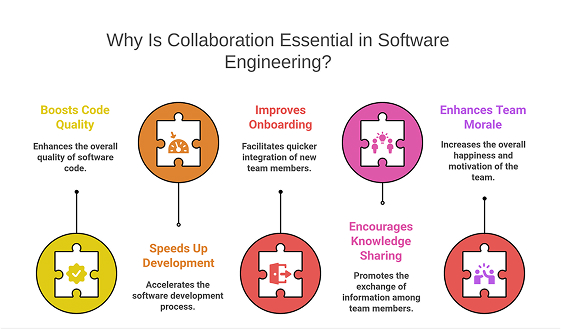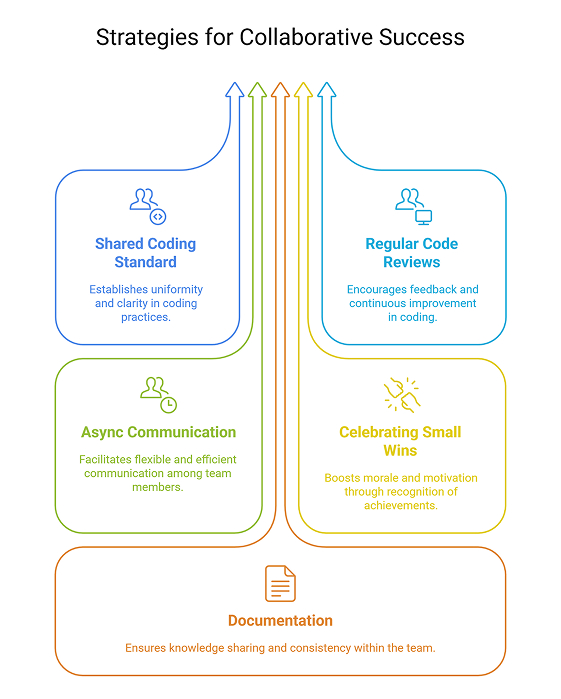Collaboration is a key pillar of success in software development; sharing knowledge while distributing responsibilities has become essential within the team.
From startups to global enterprises, collaboration decides how products are developed, designed, tested, and delivered. But what makes it so powerful? How can teams collaborate better?
Let’s take a look at what makes collaboration work in software development.
What Is Collaborative Software Development?
A collaborative approach to software development involves individual developers or whole teams focused on a particular codebase, features, or problems, using shared resources, communication tools, and workflows.
Collaboration isn’t just about team coding. It includes:
- Continuous communication across teams
- Code reviews and pair programming
- Version control using Git
- Agile or DevOps-based workflows
The goal of collaborative software development is simple: faster delivery, fewer bugs, and better team alignment.
Why Is Collaboration Essential in Software Engineering?
Software is no longer built in silos. With complex architectures, ever-changing requirements, and cross-functional teams, collaboration has become essential.

Here’s why collaboration matters:
- Boosts code quality When developers review each other’s work or pair-program on tricky problems, bugs are caught early. The result is cleaner and more reliable code.
- Enhances engineering productivity and efficiency: Parallel workflows and clear task assignments ensure that multiple features can be developed simultaneously while minimizing overlap and conflicts among team members.
- Improves onboarding: New team members can learn faster in a highly collaborative environment by asking questions, reading documentation, or shadowing others.
- Encourages knowledge sharing: No more “only one person knows how this works.” Knowledge is distributed, reducing dependency on specific individuals.
- Enhances team morale: A shared sense of purpose builds a healthier team culture. Taking pride in your work is easier when you are part of something bigger.
What Makes a Highly Collaborative Software Development Process?
Not all collaborative environments are created equal. Some teams collaborate better than others – it’s not just about using communication tools.
Here’s what makes a highly collaborative software development process stand out:
- Defined roles with flexible boundaries: Developers, designers, testers, and project managers should know their roles but be willing to help each other.
- Code visibility: Anyone should be able to see what others are working on and understand what they do.
- Strong tooling: Version control, CI/CD pipelines, and collaboration tools (Jira, Trello, or Linear, etc.) are essential.
- Regular check-ins: Stand-ups, retros, and demos keep everyone informed.
- Psychological safety: Developers should feel safe speaking up, raising issues, or suggesting changes without fear of blame.
“The best software doesn’t come from individuals-it comes from teams who listen, question, and build together.”
Real-Life Examples of Collaborative Development
Many of the best-known software teams rely on deep collaboration:
- GitLab is built entirely by a distributed team that collaborates on their product.
- Microsoft developers across the globe co-author code using Visual Studio Live Share.
- Open-source projects like Kubernetes and React thrive on global contributor collaboration, often asynchronously.
In these cases, teams aren’t just writing code; they’re writing it together, reviewing it together, and solving complex problems by pooling their strengths.
How Can You Improve Collaboration in Your Team?
Ready to level up your team’s collaboration? Start with these simple steps:
- Adopt a shared coding standard: Agree on code formatting, naming conventions, and practices to avoid messy merge conflicts and inconsistent code.
- Schedule regular code reviews: Make code reviews a habit. They’re not just for catching bugs – they’re for sharing ideas and improving team skills.
- Use asynchronous communication wisely: Not every message needs a meeting. Tools like Slack threads, Notion pages, and GitHub comments are perfect for asynchronous updates.
- Celebrate small wins: Acknowledge great commits, successful deployments, or problem-solving moments. It builds trust and motivation.
- Don’t ignore documentation: Great collaboration thrives on shared knowledge. Make documentation part of the dev process, not an afterthought.

Frequently Asked Questions
1. What tools help with collaborative development?
Popular tools include Git, GitHub, GitLab, Bitbucket, VS Code Live Share, Slack, Trello, Jira, Notion, and Zoom. These streamline communication, planning, and coding together.
2. How does collaborative development differ from traditional development?
Traditional development often relies on individual ownership and sequential workflows. Collaborative development, on the other hand, embraces shared ownership, parallel tasks, and team accountability.
3. Is remote collaboration effective in software engineering?
Absolutely. With the right tools and culture, remote collaboration can be as effective – or even more productive – than in-person work. Many successful open-source and SaaS companies prove this every day.
Final Thoughts
In today’s software world, collaborative development in software engineering is more than a convention – it’s necessary. As systems grow more complex and teams more distributed, success depends not just on writing code but on working together with purpose.
Collaboration is where engineering meets empathy. When done right, it produces not just better software but also better developers.
